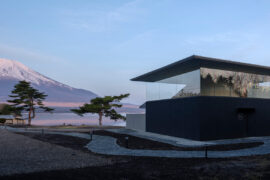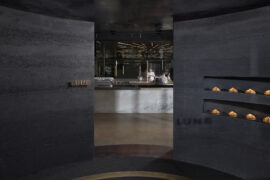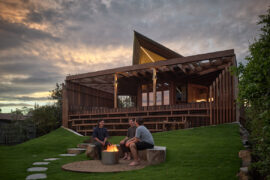How can a historical building remain relevant for the next century? Architect Jun Aoki transforms a key Kyoto cultural site for contemporary relevance.

Photo by Joanna Kawecki
March 23rd, 2020
After nine decades, one of Japan’s oldest public art museums in Kyoto has unveiled its first, highly-anticipated renewal since the buildings historic completion in 1933. The Kyoto City Kyocera Museum of Art has welcomed a modern transformation of the original Imperial Crown western style structure with a striking new entrance and brand new annex, intended to house and present the museum’s contemporary works.

Photo by Joanna Kawecki
The large-scale renovation was led by renowned Japanese architect Jun Aoki, who aimed to create a new design to “seek continuity whilst adding a new layer”. Aoki, whose projects include Louis Vuitton Japan retail stores and the Aomori Museum of Art, recognised the historical site held structural and preservation constraints and saw them as an advantage. Aoki explains, “My idea was to allow a new visage to emerge while preserving the underlying architecture.”

Photo by Joanna Kawecki
For the project, Aoki worked alongside Kyoto-born architect Tezzo Nishizawa, a former architect at Jun Aoki & Associates who had led the firm’s design for Aomori Museum of Art. Both architects brought complementing perspectives to the concept and approach with their “similar attitude towards architecture,” as noted by Aoki. “We decided to join together on this project due to Tezzo’s extensive experience in renovation and gallery interiors, such as his renewal of the collection room galleries at the Tokyo National Museum.”

Photo by Takeru Koroda
The museum now boasts a striking new entrance created by joining glass panels to create an undulating glass ribbon form, where visitors are drawn into the museum from a sloping, piazza-like open public area, furthermore leading to new museum cafe and retail spaces. “We used a very delicate treatment of the slope angles to encourage people to come to the museum, and to gather and interact.” Aoki notes.

Photo by Takeru Koroda
The building’s interior navigation was originally deemed austere and unaccommodating due to the narrow and uninviting entrance. Aoki and Nishizawa decided to utilise the basement as the main entry point with a new staircase leading towards exhibition halls and the rear Japanese garden. A rooftop area, open free to the public 24 hours a day, sits atop the new annex building and museum storage facility. The interconnected spaces add a sense of harmony and fluidity. Aoki explains, “If you can feel some continuity or some penetration into the building, you can feel more comfortable. By connecting the west and east of the building, I tried to draw out the museum’s embedded axis.”

Photo by Takeru Koroda
Aoki’s use of repetition can be found, with curvatures found balcony contours to the central spiral staircase and the building’s sinuous entrance. Aoki’s use of GFRC (glass fibre reinforced concrete) utilised in a former project, was reinterpreted to reflect the buildings historic brick facade. The limestone-like modules include slender stainless steel panels that reflect light throughout the day, creating an ever-changing atmosphere. Whilst making additional updates such as seismic reinforcements to meet current regulations, the architect’s intention was to reinvigorate the historic 90-year-old structure in a modern context and remain for another century as; “A Museum Where Time Converges”.

Photo by Joanna Kawecki
If you liked this article, we think you’d enjoy an article The 123s of Architecture.
INDESIGN is on instagram
Follow @indesignlive
A searchable and comprehensive guide for specifying leading products and their suppliers
Keep up to date with the latest and greatest from our industry BFF's!

A curated exhibition in Frederiksstaden captures the spirit of Australian design
The new range features slabs with warm, earthy palettes that lend a sense of organic luxury to every space.

Rising above the new Sydney Metro Gadigal Station on Pitt Street, Investa’s Parkline Place is redefining the office property aesthetic.

London-based design duo Raw Edges have joined forces with Established & Sons and Tongue & Groove to introduce Wall to Wall – a hand-stained, “living collection” that transforms parquet flooring into a canvas of colour, pattern, and possibility.

With prime views over Japan’s Mount Fuji, Yū Momoeda’s sauna facility defies typical standards to respond to the undulations of nature.

The North Building at the Art Gallery of New South Wales is complete. Part of the Sydney Modern Project and designed by Japanese practice SANAA, with Architectus as executive architects, it is a magical, ethereal spatial experience and a globally significant building.
The internet never sleeps! Here's the stuff you might have missed

Cieran Murphy has been awarded The Photographer – Commercial at the INDE.Awards 2025. His work on Lune Rosebery captures the immersive design and storytelling of the space, highlighting the interplay of form, material and atmosphere in this contemporary culinary destination.

Carr’s largest residential project to date integrates concrete, steel mesh and landscape across 122 apartments in Melbourne’s Brunswick.

Recognised as a winner at the INDE.Awards 2025, Barton Taylor has received The Photographer – Residential accolade. His photographic work on Cake House captures the soul of a coastal icon reimagined, blending light, texture and atmosphere into a compelling visual narrative.